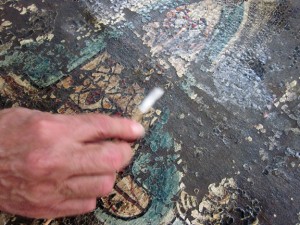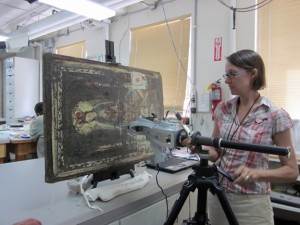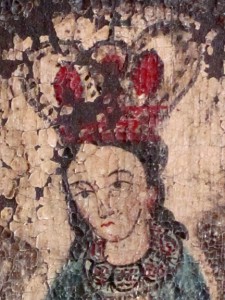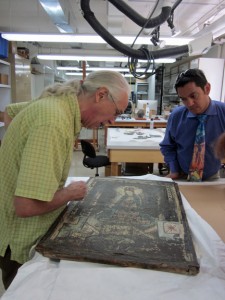Could another painting be lurking beneath the cracked surface of Nuestra Señora de San Juan de los Lagos (Our Lady of Saint John of the Lakes)? Conservator Steven Prins carried that question to the Conservation Laboratory of the Museums of New Mexico this week, hoping that some high-tech equipment and the help of the museums’ conservators might lead to answers.
The painting comes from the New Mexico History Museum’s Larry Frank Collection and was likely created around 1840 by José Aragón, a master santero whose bultos and retablos are on display in the museum’s Tesoros de Devoción exhibition. Josef Diaz, curator of Southwest and Mexican Colonial Collections, hopes to include it in a 2014 exhibition, Painting the Divine: Images of Mary in the New World. First, though, he needed to see what it would take to clean it and preserve it, so brought in Prins to have a look.
 The painting’s surface, waxy and coated with soot, has cracked and flaked to the point its underskin peeks out — something that tantalized Prins, who thought he spied the hand of another artist beneath Aragón’s. He did a bit of spot-cleaning with a cotton swab and mineral spirits, and a faint hint of black lines and red spaces appeared.
The painting’s surface, waxy and coated with soot, has cracked and flaked to the point its underskin peeks out — something that tantalized Prins, who thought he spied the hand of another artist beneath Aragón’s. He did a bit of spot-cleaning with a cotton swab and mineral spirits, and a faint hint of black lines and red spaces appeared.
On Monday, Aug. 6, Prins and the painting came to the Conservation Lab, where Associate Conservator Mina Thompson aimed some high-tech devices at its surface in hopes of uncovering more information.
From inspecting the canvas and the stretcher’s construction, Prins can already make a few assumptions. “It suggests possibly Peru, but I don’t want to go out on a limb and say it’s that,” he said. “The construction is characteristic of a Spanish Colonial painting. … It looks like an old painting that was already damaged when it was re-primed and re-painted.”
Diaz suspects that an underlying painting — if it exists — was created in Mexico and brought to Santa Fe where it suffered some type of damage, most likely drips from one of our notoriously leaky flat roofs. Aragón may have been eager to try his hand at the canvas medium or may have simply accommodated the owners’ request that he repaint the original image or create a new one.
 Thompson brought out two pieces of equipment: MuSIS, a multi-spectral imaging tool that interprets artifacts in different wavelength bands, from ultraviolet to infrared, in effect “seeing” it in layers; and the lab’s trusty pXRF, an X-ray fluorescence machine that can detect elements heavier than silicon in the periodic table. By comparing the machines’ results with those obtained from other artifacts, conservators can make reasonably solid assumptions about how things were made, with what materials and, sometimes, in what time period.
Thompson brought out two pieces of equipment: MuSIS, a multi-spectral imaging tool that interprets artifacts in different wavelength bands, from ultraviolet to infrared, in effect “seeing” it in layers; and the lab’s trusty pXRF, an X-ray fluorescence machine that can detect elements heavier than silicon in the periodic table. By comparing the machines’ results with those obtained from other artifacts, conservators can make reasonably solid assumptions about how things were made, with what materials and, sometimes, in what time period.
They took a series of images, double-checking them on a laptop screen as they went, trying to determine whether a shadow here meant X and a brightness there meant Y. Their best immediate results came when the pXRF was used to test the color red in different parts of the painting — the suspected “old” painting and Aragón’s. The patch of older paint proved to contain lead while the newer part showed mercury. That supports a hypothesis that the two were painted by different people, possibly in different eras, and maybe as many as 100 years apart.
But, Thompson said, “We have a lot more work to do.” They need to analyze more areas and compare the machines’ results with tests from other objects for further confirmation and they hope to take a leap into even more precise testing tools.
 Technological advances tend to roll faster than most museum systems’ abilities to keep up, so equipment more wiz-bang than the Conservation Lab’s capabilities are needed to firm up our knowledge of Our Lady.
Technological advances tend to roll faster than most museum systems’ abilities to keep up, so equipment more wiz-bang than the Conservation Lab’s capabilities are needed to firm up our knowledge of Our Lady.
Now that they know the painting’s likely holding onto a secret, Thompson, Diaz, and Prins are hoping to take it to a medical facility’s imaging technology as a next step.
The goal is to know more of the painting’s story; no one expects to find a masterpiece so fine that it’s worth removing the Aragón painting to reveal it. Diaz is particularly impressed with the fine details and gracefully simple expression that Aragón achieved on Mary’s face. Prins is impressed with Aragón himself.
“He was not at all influenced by formal Spanish painting,” Prins said. “He didn’t give a hoot about what was going on in the academies. These were folk artists with no pretense to academic style. They were their own counter-culture, and that’s one of the great things about them.”


Pingback: NM History Museum News Blog » Blog Archive » Our Lady Takes a Trip to the Doctor